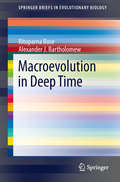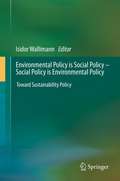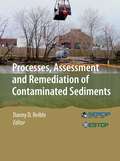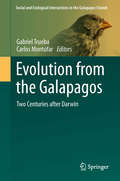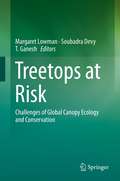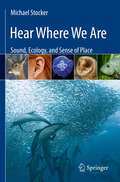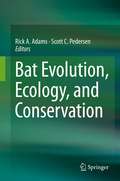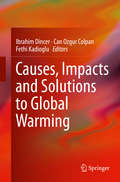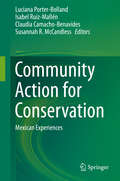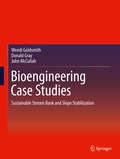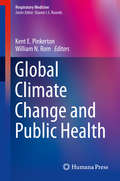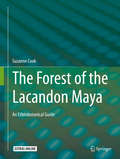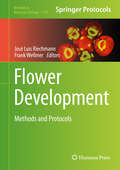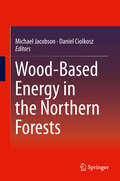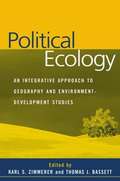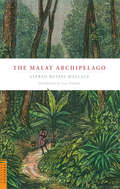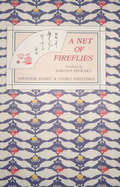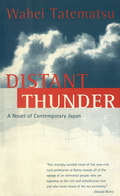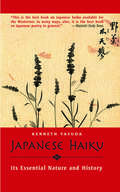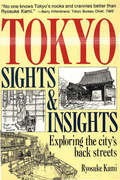- Table View
- List View
Macroevolution in Deep Time
by Alexander J. Bartholomew Rituparna BoseThe prerequisite to investigating the underlying causes behind mass extinction is a profound understanding of the evolutionary history of both living and dead species. It is especially important to appreciate the significance of such studies in extinct organisms; especially in organisms that were abundant in a certain geologic era, but have subsequently dwindled or become extinct. Such studies should help to accurately evaluate patterns of evolution in extinct species lineages and help predict the same in its modern analogs. The book includes cutting edge research in evolutionary biology that should serve as a starting point for conservation.
Environmental Policy is Social Policy – Social Policy is Environmental Policy
by Isidor WallimannThis book argues that social and environmental policy should be synthetically treated as one and the same field, that both are but two aspects of the same coin - if sustainability is the goal. Such a paradigm shift is indicated, important, and timely to effectively move towards sustainability. This book is the first to take this approach and to give examples for it. Not to synthetically merge the two fields has been and will continue to be highly insufficient, inefficient and contradictory for policy and public administration aiming for a transformation towards a sustainable world. In general, social problems are dealt with in one "policy corner" and environmental problems in another. Rarely is social policy (at large) concerned with its impact on the environment or its connection with and relevance to environmental policy. Equally, environmental problems are generally not seen in conjunction with social policy, even though much environmental policy directly relates to health, nutrition, migration and other issues addressed by social policy. This book intends to correct the pattern to separate these very significant and large policy fields. Using examples from diverse academic and applied fields, it is shown how environmental policy can (and should) be thought of as social policy - and how social policy can (and should) simultaneously be seen as environmental policy. Tremendous benefits are to be expected.
Processes, Assessment and Remediation of Contaminated Sediments
by Danny D. ReibleThe purpose of this book is to help engineers and scientists better understand contaminated sediment sites and identify and design remedial approaches that are more efficient and effective. Contaminated sediment management is a difficult and costly exercise that is rarely addressed with easily identified and implemented remedies. It is hoped that this book can help identify and implement management approaches that provide an optimal, if not entirely satisfactory, solution to sediment contaminant problems.
Evolution from the Galapagos: Two Centuries after Darwin
by Carlos Montúfar Gabriel TruebaThis volume is a collection of the some of the most significant lectures that well-known experts presented at our two international "summits on evolution" (2005, 2009) as updated and revised chapters. The meetings took place on one of the large islands of the Galapagos archipelago (San Cristobal) at GAIAS (Galapagos Institute for the Arts and Sciences) of the Universidad San Francisco de Quito (USFQ), Ecuador. The main goal of the two Galapagos Summits on Evolution has been to bring together scientists and graduate students engaged in the study of evolution, from life's origin to its current diversity. Because of their historical significance, the Galapagos are a unique venue for promoting comprehensive research on evolution and ecology and to make the research results available to students and teachers everywhere, but especially from developing countries. As shown by the enthusiastic attendance at both summits and the many suggestions to keep them continuing, the meetings have opened new opportunities for students from Ecuador and other Latin American countries to be inspired by some of the most brilliant minds in evolutionary science.
Treetops at Risk: Challenges of Global Canopy Ecology and Conservation
by Margaret Lowman Soubadra Devy T. GaneshForest canopies not only support high terrestrial biodiversity but also represent a critical interface between the atmosphere and the earth. They provide goods and services to support diverse human communities and offer opportunities to explore sustainable use of these resources for many generations of local livelihoods. Forest canopies are important carbon sequestration units, and in this sense, serve as climate control for the planet. Canopies are important energy production centers for the planet, and serve as the basis for many food chains. The canopy can also act as a hook for education outreach and conservation, inspiring ecotourism through recreation and other sustainable uses such as treetop walks, zip lines, and birding. Despite these critical services provided by forest canopies, almost no dedicated research in the treetops was initiated until as recently as the late 1970s when single rope techniques were developed by mountaineering professionals and adapted for use in the canopy. Subsequently, an array of canopy access tools was designed in the 1980s and early 1990s that have opened up this "eighth continent" for global exploration and discovery. This volume uses the major findings of the 5th international canopy conference as a platform for organization, but it does not mimic the sessions and presentations of the conference itself. Instead, it builds on the important themes that emerged from the conference and solicits articles that represent future priorities and advancements for canopy science in the next decade. Despite the global efforts of hundreds of forest scientists over the past 3 decades, forests are degrading at an accelerated rate and biodiversity is increasingly threatened by human activities. Given these trends - despite the very best efforts of the world's best scientists - other approaches must be taken. This volume summarizes the issue of "treetops at risk" and assembles a global authorship to examine past accomplishments and future initiatives critical in forest conservation.
Hear Where We Are: Sound, Ecology, and Sense of Place
by Michael StockerThroughout history, hearing and sound perception have been typically framed in the context of how sound conveys information and how that information influences the listener. "Hear Where We Are" inverts this premise and examines how humans and other hearing animals use sound to establish acoustical relationships with their surroundings. This simple inversion reveals a panoply of possibilities by which we can re-evaluate how hearing animals use, produce, and perceive sound. Nuance in vocalizations become signals of enticement or boundary setting; silence becomes a field ripe in auditory possibilities; predator/prey relationships are infused with acoustic deception, and sounds that have been considered territorial cues become the fabric of cooperative acoustical communities. This inversion also expands the context of sound perception into a larger perspective that centers on biological adaptation within acoustic habitats. Here, the rapid synchronized flight patterns of flocking birds and the tight maneuvering of schooling fish becomes an acoustic engagement. Likewise, when stridulating crickets synchronize their summer evening chirrups, it has more to do with the 'cricket community' monitoring their collective boundaries rather than individual crickets establishing 'personal' territory or breeding fitness. In "Hear Where We Are" the author continuously challenges many of the bio-acoustic orthodoxies, reframing the entire inquiry into sound perception and communication. By moving beyond our common assumptions, many of the mysteries of acoustical behavior become revealed, exposing a fresh and fertile panorama of acoustical experience and adaptation.
Bat Evolution, Ecology, and Conservation
by Rick A. Adams Scott C. PedersenRecent advances in the study of bats have changed the way we understand this illusive group of mammals. This volume consist of 25 chapters and 57 authors from around the globe all writing on the most recent finding on the evolution, ecology and conservation of bats. The chapters in this book are not intended to be exhaustive literature reviews, but instead extended manuscripts that bring new and fresh perspectives. Many chapters consist of previously unpublished data and are repetitive of new insights and understanding in bat evolution, ecology and conservation. All chapters were peer-reviewed and revised by the authors. Many of the chapters are multi-authored to provide comprehensive and authoritative coverage of the topics.
Causes, Impacts and Solutions to Global Warming
by Ibrahim Dincer Can Ozgur Colpan Fethi KadiogluGlobal Warming: Causes, Impacts and Solutions covers all aspects of global warming including its causes, impacts, and engineering solutions. Energy and environment policies and strategies are scientifically discussed to expose the best ways to reduce global warming effects and protect the environment and energy sources affected by human activities. The importance of green energy consumption on the reduction of global warming, energy saving and energy security are also discussed. This book also focuses on energy management and conservation strategies for better utilization of energy sources and technologies in buildings and industry as well as ways of improving energy efficiency at the end use, and introduces basic methods for designing and sizing cost-effective systems and determining whether it is economically efficient to invest in specific energy efficiency or renewable energy projects, and describes energy audit producers commonly used to improve the energy efficiency of residential and commercial buildings as well as industrial facilities. These features and more provide the tools necessary to reduce global warming and to improve energy management leading to higher energy efficiencies. In order to reduce the negative effects of global warming due to excessive use of fossil fuel technologies, the following alternative technologies are introduced from the engineering perspective: fuel cells, solar power generation technologies, energy recovery technologies, hydrogen energy technologies, wind energy technologies, geothermal energy technologies, and biomass energy technologies. These technologies are presented in detail and modeling studies including case studies can also be found in this book.
Community Action for Conservation: Mexican Experiences
by Luciana Porter-Bolland Isabel Ruiz-Mallén Claudia Camacho-Benavides Susannah R. MccandlessThis book provides an in-depth analysis on community conservation in Mexico. The volume explores vivid examples and case studies that illustrate some of the critical issues at stake, including the participation of local communities in national and global conservation, indigenous and local perceptions of conservation initiatives in Southern Mexico, and challenges in ICCA governance and ecotourism. The book also reviews methodological approaches for understanding and strengthening community conservation, touching upon such topics as community-based biodiversity monitoring and tools for understanding children's perceptions of community conservation. Written by international experts in the field, Community Action for Conservation: Mexican Experiences is a lively and deep-running resource that offers invaluable stories and analyses of the Mexican experience with conservation.
Bioengineering Case Studies: Sustainable Stream Bank and Slope Stabilization
by Wendi Goldsmith Donald Gray John Mccullah"Bio-Stabilization Case Studies: Treatment and Performance Evaluation" describes and evaluates 30 projects from across the United States where bio-stabilization was employed to address a detrimental naturally occurring process or byproduct of the built environment. Bio-stabilization (or soil bioengineering) refers to the use of plant materials, primarily live cuttings, arranged in the ground in different arrays to reinforce soils and protect upland slopes and/or stream banks against surficial erosion and shallow slope failures. Examples included in the collection represent different regions of the country and their specific conditions and challenges. Each project is illustrated with a number of distinctive photographs to support the reader's understanding and showcase the wide scope of projects and techniques presented. The volume is ideal for civil and environmental engineers and environmental scientists working on watershed, infrastructure projects, and municipal scale installations.
Global Climate Change and Public Health
by William N. Rom Kent E. PinkertonPulmonary physicians and scientists currently have minimal capacity to respond to climate change and its impacts on health. The extent to which climate change influences the prevalence and incidence of respiratory morbidity remains largely undefined. However, evidence is increasing that climate change does drive respiratory disease onset and exacerbation as a result of increased ambient and indoor air pollution, desertification, heat stress, wildfires, and the geographic and temporal spread of pollens, molds and infectious agents. Preliminary research has revealed climate change to have potentially direct and indirect adverse impacts on respiratory health. Published studies have linked climate change to increases in respiratory disease, including the following: changing pollen releases impacting asthma and allergic rhinitis, heat waves causing critical care-related diseases, climate driven air pollution increases, exacerbating asthma and COPD, desertification increasing particulate matter (PM) exposures, and climate related changes in food and water security impacting infectious respiratory disease through malnutrition (pneumonia, upper respiratory infections). High level ozone and ozone exposure has been linked to idiopathic pulmonary fibrosis, lung cancer, and acute lower respiratory infection. Global Climate Change and Public Health is an important new volume based on the research, findings, and discussions of US and international experts on respiratory health and climate change. This volume addresses issues of major importance to respiratory health and fills a major gap in the current literature. The ATS Climate Change and Respiratory Health Workshop was held in New Orleans, Louisiana, on May 15, 2010. The purpose of the meeting was to address the threat to global respiratory health posed by climate change. The workshop was attended by domestic and international experts as well as representatives of international respiratory societies and key US federal agencies. Dr. Pinkerton and Dr. Rom, the editors of this title, were co-chairs of the Climate Change Workshop and Symposium.
The Forest of the Lacandon Maya
by Suzanne CookThe Forest of the Lacandon Maya: An Ethnobotanical Guide, with active links to audio-video recordings, serves as a comprehensive guide to the botanical heritage of the northern Lacandones. Numbering fewer than 300 men, women, and children, this community is the most culturally conservative of the Mayan groups. Protected by their hostile environment, over many centuries they maintain autonomy from the outside forces of church and state, while they continue to draw on the forest for spiritual inspiration and sustenance. In The Forest of the Lacandon Maya: An Ethnobotanical Guide, linguist Suzanne Cook presents a bilingual Lacandon-English ethnobotanical guide to more than 450 plants in a tripartite organization: a botanical inventory in which main entries are headed by Lacandon names followed by common English and botanical names, and which includes plant descriptions and uses; an ethnographic inventory, which expands the descriptions given in the botanical inventory, providing the socio-historical, dietary, mythological, and spiritual significance of most plants; and chapters that discuss the relevant cultural applications of the plants in more detail provide a description of the area's geography, and give an ethnographic overview of the Lacandones. Active links throughout the text to original audio-video recordings demonstrate the use and preparation of the most significant plants.
Flower Development
by José Luis Riechmann Frank WellmerIn Flower Development: Methods and Protocols, researchers in the field detail protocols for experimental approaches that are currently used to study the formation of flowers, from genetic methods and phenotypic analyses, to genome-wide experiments, modeling, and system-wide approaches. Written in the highly successful Methods in Molecular Biology series format, chapters include introductions to their respective topics, lists of the necessary materials and reagents, step-by-step, readily reproducible laboratory protocols, and key tips on troubleshooting and avoiding known pitfalls Authoritative and practical, Flower Development: Methods and Protocols is an essential guide for plant developmental biologists, from thenovice to the experienced researcher, and for those considering venturing into the field. "
Wood-Based Energy in the Northern Forests
by Michael Jacobson Daniel CiolkoszThis unique book provides the first comprehensive overview of wood based bioenergy in the northern hardwood forests of the Eastern United States. This includes a holistic look at the topic of wood based bioenergy, as well as focused analyses of key topics. This book is relevant to engineers, project developers, foresters, economists, sociologists, environmental scientists and natural resource managers. Most chapters also provide practical hands-on advice for the practitioner, and provide a valuable resource for anyone who is considering developing a woody bioenergy project.
Political Ecology
by Karl Zimmerer Thomas J. BassettThis volume offers a unique, integrative perspective on the political and ecological processes shaping landscapes and resource use across the global North and South. Twelve carefully selected case studies demonstrate how contemporary geographical theories and methods can contribute to understanding key environment-and-development issues and working toward effective policies. Topics addressed include water and biodiversity resources, urban and national resource planning, scientific concepts of resource management, and ideas of nature and conservation in the context of globalization. Giving particular attention to evolving conceptions of nature-society interaction and geographical scale, an introduction and conclusion by the editors provide a clear analytical focus for the volume and summarize important developments and debates in the field.
The Malay Archipelago (Periplus Classics Series)
by Alfred Russel WallaceThis is one the first and most important books about 18th century Malaysia and covers a wide array of topics from Malaysian culture and history to nature and wildlife. It is essential reading for anyone interested in Malaysia.<P><P>A century and a half after it was first published, this book remains one of the great classics of natural history and travel--perhaps the greatest. Alfred Russel Wallace (1823-1913) deserves equal billing with Charles Darwin for his independently drawn but parallel conclusions on the theory of evolution. Darwin himself called Wallace "generous and noble" and referred favorably to his work in later editions of The Origin of Species.The Malay Archipelago is an extraordinarily accessible book. There is a wealth of detail about pre-modern life in the Indonesian archipelago which Wallace accumulated on over 60 separate journeys spanning 14,000 miles. He was equally fascinated by the exotic peoples, flora and fauna he encountered in his epic travels. A mark of his achievement lies in the size of the collections he bequeathed to British museums--some 125,000 specimens ranging from large mammals to tiny insects, exotic butterflies and splendid birds of paradise.
The American Boy's Handy Book
by Daniel C. BeardLong before a "dangerous" book was all the rage there was The American Boy's Handy Book by Daniel Beard, a beloved classic for generations of youngsters. Specially designed to provide loads of ideas for adventures and games both indoors and outdoors during each season of the year, The American Boy's Handy Book was originally published in 1882 and became an instant bestseller.Now, Tuttle Publishing is bringing this much-loved book back for a new generation of boys to enjoy. If you're not too young to fly a kite or too old to enjoy a day fishing, The American Boy's Handy Book is chock full of fun activities intended just for you! There's something for every day of the year: making an aquarium, rigging and sailing small boats, camping without a tent, making a cornstalk fiddle, trapping, building a snow fort, and of course tons of other games and crafts, too.Daniel Beard firmly believed in letting boys make their own playthings, encouraging them to value their own hard work and gain the skills needed throughout life to successfully invent, construct and dream. In this world of instant gratification with ever-younger generations coveting the ubiquitous cell phones, computers and iPods, it seems as though the imagination and sense of adventure that permeated our country's past have all but disappeared. Welcome back the joys of childhood with The American Boy's Handy Book, and prepare to make old favorites new again!
A Net of Fireflies
by Harold StewartA Net of Fireflies is a Collection of Japanese Haiku and Haiku paintings.
A Net of Fireflies
by Harold StewartA Net of Fireflies is a Collection of Japanese Haiku and Haiku paintings.
Distant Thunder
by Wahei TatematsuWinner of the Noma Prize for New WritersSet in rural Japan at the height of the bubble economy, Distant Thunder tells of a farming village gradually effaced by urbanization, corruption, and greed. After Matsuzo Wada has sold off the family's lands and left his wife for another woman, his son Mitsuo is determined to support himself and his mother in the traditional manner, farming. All that remains of his ancestors' lands is a hothouse, in which he grows tomatoes to sell to the housewives from the nearby apartment complex, built on a former rice field. When his childhood friend, Koji, becomes entangled in an adulterous love affair which ultimately destroys him and those around him, Mitsuo begins to see how the town's hedonistic excesses are laying to waste not only the landscape, but also the communal and familial bonds and the values that once sustained them all.Translated from the Japanese by Lawrence J. Howell and Hikaru Morimoto.
Japanese Haiku
by Kenneth YasudaThis is the most authoritative and concise book on Japanese haiku available: what it is, how it developed, and how it is practiced in both Japanese and English. While many haiku collections are available to Western readers, few books combine both translated haiku with haiku written originally in English, along with an analysis of individual poems and of the haiku form itself. Written by a leading scholar in the field--Kenneth Yasuda was the first American to receive a doctorate in Japanese literature from Tokyo University--Japanese Haiku has been widely acclaimed. This edition is completely repackaged for 2002, and is the perfect book for lovers of poetry who do not have a solid background in haiku.
Tokyo Sights and Insights
by Ryosuke KamiTokyo Sights and Insights is the unique work of Ryosuke Kami, artist, essayist, and native Tokyoite. Weekends Mr. Kami bicycles about his favorite city in search of Tokyo sights to capture on his sketch pad; weeknights he draws on these same sketches to produce the insights that fill this book.Don't look for Ryosuke Kami's sights in other books about Tokyo. Among his subjects are a surviving "milk hall," a replica of Mt. Hakone in the middle of Shinjuku, one shogun's ill-fated flagship, another shogun's lighthouse, and a tempura restaurant in the old Yoshiwara pleasure quarters that continues to serve patrons to this very day.Mr. Kami 's insights on matters historical, cultural, and quizzical are original too. From his book you will learn such things as the connection between bone-setting and judo, why people from Fukushima distrust those from Yamaguchi, why seaweed shops are located in Nihombashi, the unlikely fate of the last Tokugawa shogun, and the unlucky voyage of the Lucky Dragon V. It is common knowledge that Tokyo is one of the largest cities in the world; less well known is that it is also one of the world's most interesting . Unfortunately most visitors and many residents never begin to appreciate Tokyo. Ryosuke Kami , though, has spent years exploring and reflecting on his native city. The result is Tokyo Sights and Insights, a book certain to delight and educate first -time visitors and long-term residents alike.
Tokyo Sights and Insights
by Ryosuke KamiTokyo Sights and Insights is the unique work of Ryosuke Kami, artist, essayist, and native Tokyoite. Weekends Mr. Kami bicycles about his favorite city in search of Tokyo sights to capture on his sketch pad; weeknights he draws on these same sketches to produce the insights that fill this book.Don't look for Ryosuke Kami's sights in other books about Tokyo. Among his subjects are a surviving "milk hall," a replica of Mt. Hakone in the middle of Shinjuku, one shogun's ill-fated flagship, another shogun's lighthouse, and a tempura restaurant in the old Yoshiwara pleasure quarters that continues to serve patrons to this very day.Mr. Kami 's insights on matters historical, cultural, and quizzical are original too. From his book you will learn such things as the connection between bone-setting and judo, why people from Fukushima distrust those from Yamaguchi, why seaweed shops are located in Nihombashi, the unlikely fate of the last Tokugawa shogun, and the unlucky voyage of the Lucky Dragon V. It is common knowledge that Tokyo is one of the largest cities in the world; less well known is that it is also one of the world's most interesting . Unfortunately most visitors and many residents never begin to appreciate Tokyo. Ryosuke Kami , though, has spent years exploring and reflecting on his native city. The result is Tokyo Sights and Insights, a book certain to delight and educate first -time visitors and long-term residents alike.
